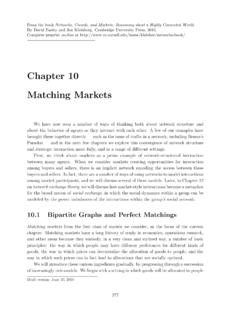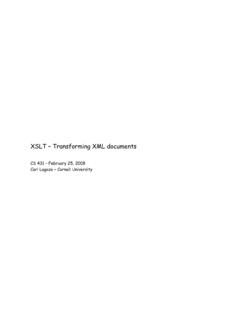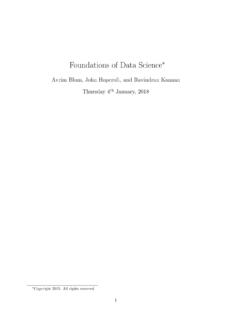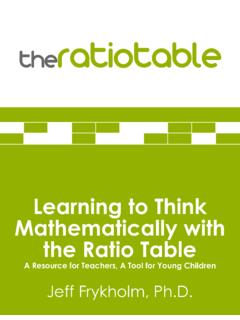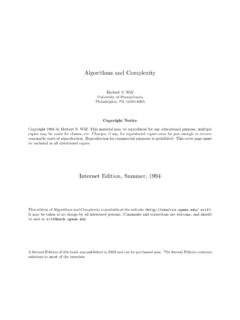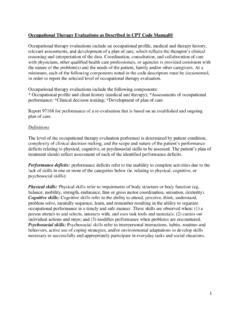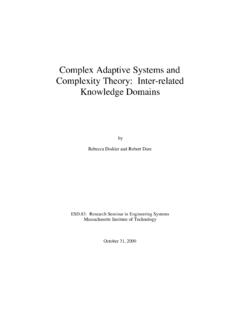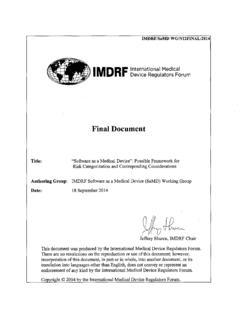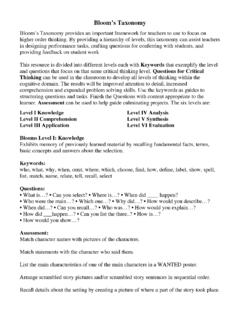Transcription of Asymptotic Running Time of Algorithms - Cornell University
1 1 Asymptotic Running Timeof AlgorithmsAsymptotic complexity : leading term analysis Comparing searching and sorting Algorithms so far: Count worst-case number of comparisons as function of array size. Drop lower-order terms, floors/ceilings, and constants to come upwith Asymptotic Running time of algorithm. We will now generalize this approach to other programs: Count worst-case number of operations executed by program as afunction of input size. Formalize definition of big-O complexity to derive asymptoticrunning time of Definition of big-O Notation: Let f(n) and g(n) be functions. We say f(n) is of order g(n),written O(g(n)), if there is a constant c > 0 such that for allbut a finite number of positive values of n:f(n) c * g(n)In other words, sooner or later g(n) overtakes f(n) as n gets large.
2 Example: f(n) = n+5; g(n) = n. Show that f(n) = O(g(n)).Choose c = 6:f(n) = n+5 6*n for all n > 0. Example: f(n) = 17n; g(n) = 3n2. Show that f(n) = O(g(n)).Choose c = 6:f(n) = 17n 6 * 3n2 for all n > 0. To prove that f(n) = O(g(n)), find an n0 and c such thatf(n) c * g(n) for all n > n0. We will call the pair (c, n0) a witness pair for proving thatf(n) = O(g(n)).2 For Asymptotic complexity , base of logarithms does not matter. Let us show that log2(n) = O(logb(n)) for any b > 1. Need to find a witness pair (c, n0) such that: log2(n) c * logb(n) for all n > n0. Choose (c = log2(b), n0 = 0). This works becausec * logb(n)= log2(b) * logb(n) = log2(blogb(n)) = log2(n)for all positive is Asymptotic complexity So Important?
3 Asymptotic complexity gives an idea of how rapidly the space/timerequirements grow as problem size increases. Suppose we have a computing device that can execute 1000 complexoperations per second. Here is the size problem that can be solved ina second, a minute, and an hour by Algorithms of different asymptoticcomplexity:211592n1533910n3109 6144183n2189724431n2200,0004893140n log n3,600,00060,0001000n1 hour1 minute1 secondComplexityWhat are the basic OPERATIONS? For searching and sorting Algorithms , you can usuallydetermine big-O complexity by counting comparisons. Why? Usually end up doing some fixed number of arithmeticand/or logical operations per comparison.
4 Why don t we count swaps for sorting? , think about selection sort: max of n swaps but must do O(n2) comparisons swaps and comparisons have similar cost Is counting number of comparisons always right? No. , selection sort on linked lists instead of arraysWhat Operations Should We Count? Must do a detailed counting of all executed operations. Estimate number of primitive operations that RAM model (basicmicroprocessor) must do to run program: Basic operation: arithmetic/logical operations count as 1 operation. even though adds, multiplies, and divides don t (usually) cost the same Assignment: counts as 1 operation. operation count of righthand side of expression is determined separately.
5 Loop: number of operations per iteration * number of loop iterations. Method invocation: number of operations executed in the invokedmethod. ignore costs of building stack frames, .. Recursion: same as method invocation, but harder to reason about. Ignoring garbage collection, memory hierarchy (caches), ..3 Example: Selection Sortpublic static void selectionSort(Comparable[] a) { //array of size nfor (int i = 0; i < ; i++) { <-- cost = c1, n times int MinPos = i; <-- cost = c2, n times for (int j = i+1; j < ; j++) { <-- cost = c3, n*(n-1)/2 times if (a[j].compareTo(a[MinPos]) < 0)<-- cost = c4, n*(n-1)/2 times MinPos = j;} <-- cost = c5, n*(n-1)/2 times Comparable temp = a[i]; <-- cost = c6, n times a[i] = a[MinPos]; <-- cost = c7, n times a[MinPos] = temp;}} <-- cost = c8, n timesTotal number of operations:= (c1+c2+c6+c7+c8)*n + (c3+c4+c5)*n*(n-1)/2= (c1+c2+c6+c7+c8 -(c3+c4+c5)/2)*n + ((c3+c4+c5)/2)*n2= O(n2)Example: Matrix Multiplicationint n = ; <-- cost = c0, 1 timefor (int i = 0; i < n; i++) { <-- cost = c1, n times for (int j = 0; j < n.)}
6 J++) { <-- cost = c2, n*n times sum = 0; <-- cost = c3, n*n times for k = 0; k < n; k++) <-- cost = c4, n*n*n times sum = sum + A[i][k]*B[k][j]; <-- cost = c5, n*n*n times C[i][j] = sum; <-- cost = c6, n*n times }}Total number of operations:= c0 + c1*n + (c2+c3+c6)*n*n + (c4+c5)*n*n*n= O(n3)Remarks For Asymptotic Running time, we do not need to count precise numberof operations executed by each statement, provided that number ofoperations is independent of input size. Just use symbolic constantslike c1, c2, .. instead. Our estimate used a precise count for the number of times the j loopwas executed in selection sort ( , n*(n-1)/2).
7 Could have said it wasexecuted n2 times and still have obtained the same big-O complexity . Once you get the hang of this, you can quickly zero in on what isrelevant for determining Asymptotic complexity . For example, you canusually ignore everything that is not in the innermost loop. Why? Main difficulty: estimating Running time for recursive programsAnalysis of Merge-Sortpublic static Comparable[] mergeSort(Comparable[] A, int low, int high){if (low < high - 1) //at least three elements<-- cost = c0, 1 time {int mid = (low + high)/2; <-- cost = c1, 1 time Comparable[] A1 = mergeSort(A, low, mid); <-- cost = ??, 1 time Comparable[] A2 = mergeSort(A, mid+1, high);<-- cost = ?}}
8 ?, 1 time return merge(A1,A2);} <-- cost = c2*n + c3 ..Recurrence equation: T(n) = (c0+c1) + 2T(n/2) + (c2*n + c3)<-- recurrence T(1) = c4<-- base caseHow do we solve this recurrence equation?4 Analysis of Merge-SortRecurrence equation: T(n) = (c0+c1) + 2T(n/2) + (c2*n + c3) T(1) = c4 First, simplify by dropping lower-order recurrence equation: T(n) = 2T(n/2) + n T(1) = 1It can be shown that T(n) = O(nlog(n)) is a solution to do we mean by Solution Recurrence:T(n) = 2T(n/2) + n Solution:T(n) = nlog2n To prove, substitute nlog2n for T(n) in recurrence:T(n) = 2T(n/2) + nnlog2n = 2(n/2)log2(n/2) + nnlog2n = nlog2(n/2) + nnlog2n = n(log2(n) - log2(2)) + nnlog2n = n(log2(n) - 1) + nnlog2n = nlog2(n) - n + nnlog2n = nlog2nSolving recurrences Solving recurrences is like integration --- no generaltechniques known for solving recurrences.
9 For CS 211, we just expect you to remember a fewcommon patterns. CS 280, learn a bag of tricks for solving recurrences thatarise in Sheet for Common RecurrencesRecurrence RelationClosed-FormExamplec(1) = ac(n) = b + c(n-1) c(n) = O(n)Linear searchc(1) = ac(n) = b*n + c(n-1) c(n) = O(n2)Quicksortc(1) = ac(n) = b + c(n/2) c(n) = O(log(n))Binary searchc(1) = ac(n) = b*n + c(n/2)c(1) = ac(n) = b + kc(n/k)5 Cheat Sheet for Common RecurrencesRecurrence RelationClosed-FormExamplec(1) = ac(n) = b + c(n-1) c(n) = O(n)Linear searchc(1) = ac(n) = b*n + c(n-1) c(n) = O(n2)Quicksortc(1) = ac(n) = b + c(n/2) c(n) = O(log(n))Binary searchc(1) = ac(n) = b*n + c(n/2) c(n) = O(n)c(1) = ac(n) = b + kc(n/k)
10 Cheat Sheet for Common RecurrencesRecurrence RelationClosed-FormExamplec(1) = ac(n) = b + c(n-1) c(n) = O(n)Linear searchc(1) = ac(n) = b*n + c(n-1) c(n) = O(n2)Quicksortc(1) = ac(n) = b + c(n/2) c(n) = O(log(n))Binary searchc(1) = ac(n) = b*n + c(n/2) c(n) = O(n)c(1) = ac(n) = b + kc(n/k) c(n) = O(n)Cheat Sheet for Common Recurrences RelationClosed-FormExamplec(1) = ac(n) = b*n + 2c(n/2) c(n) = O(nlog(n))Mergesortc(1) = ac(n) = b*n + kc(n/k) c(n) = O(nlog(n))c(1) = ac(2) = bc(n) = c(n-1) + c(n-2) + dc(n) = O(2n)Fibonacci Don t just memorize these. Try to understand each one. When in doubt, guess a solution and see if it works (just like with integration).
